























































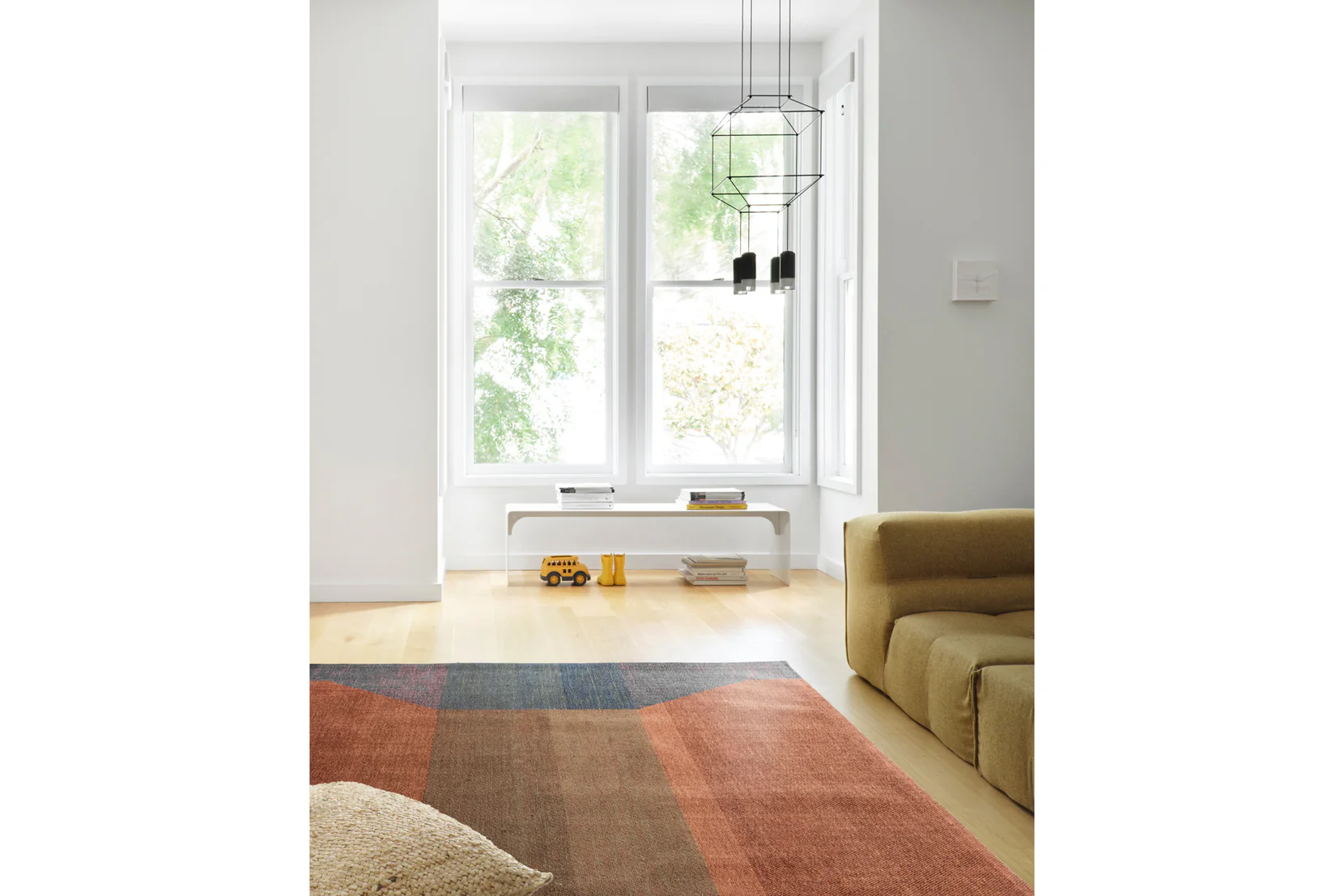


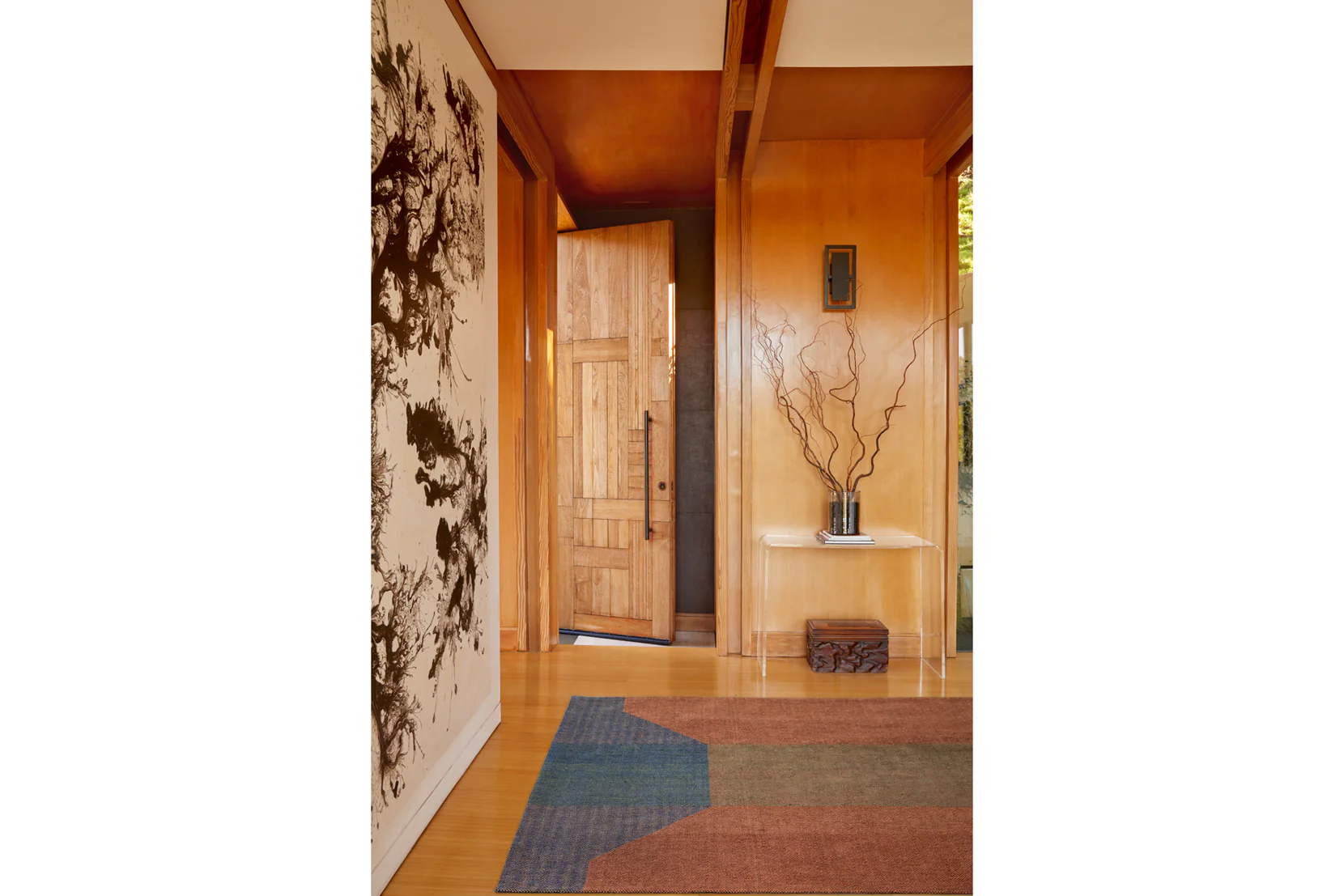


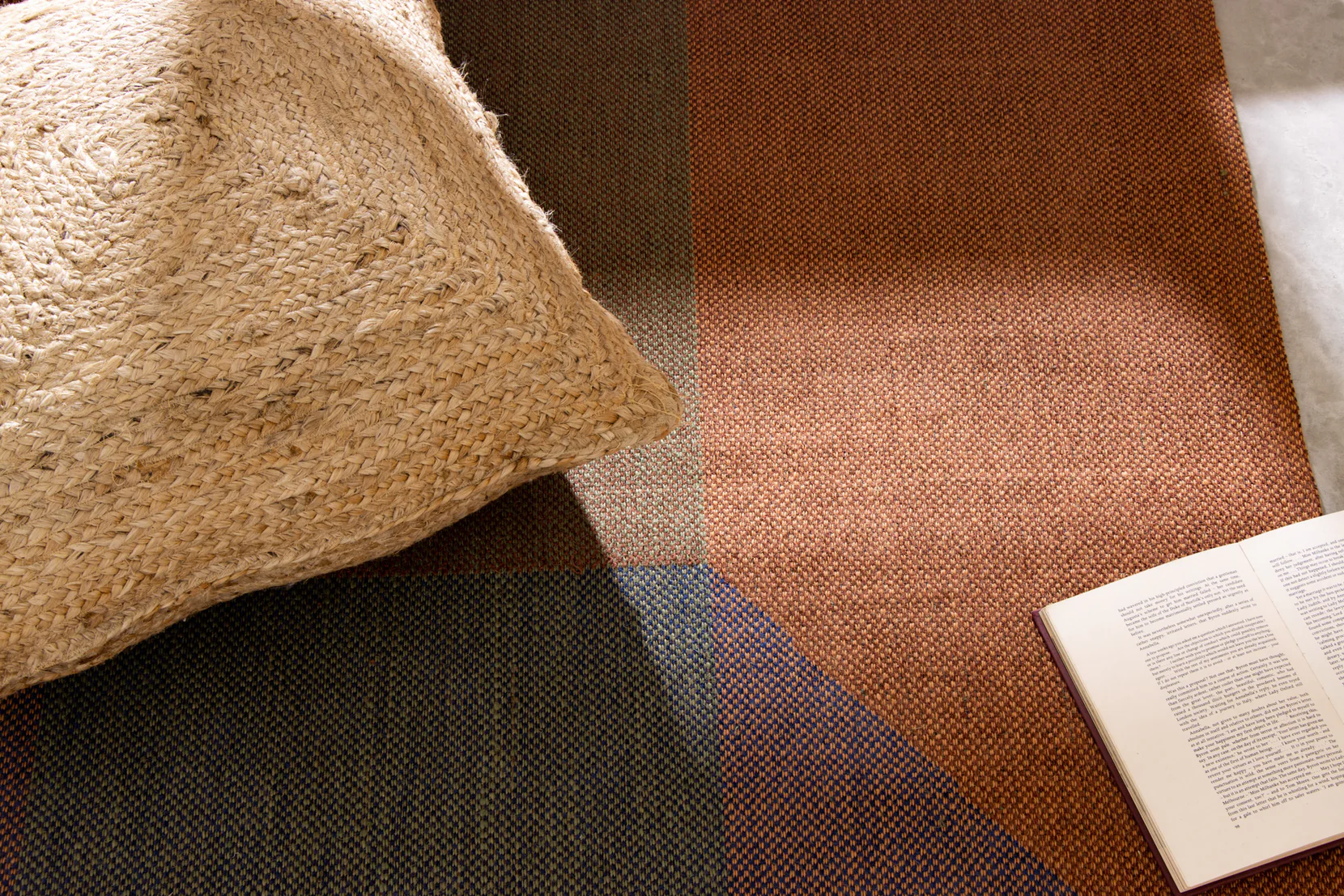


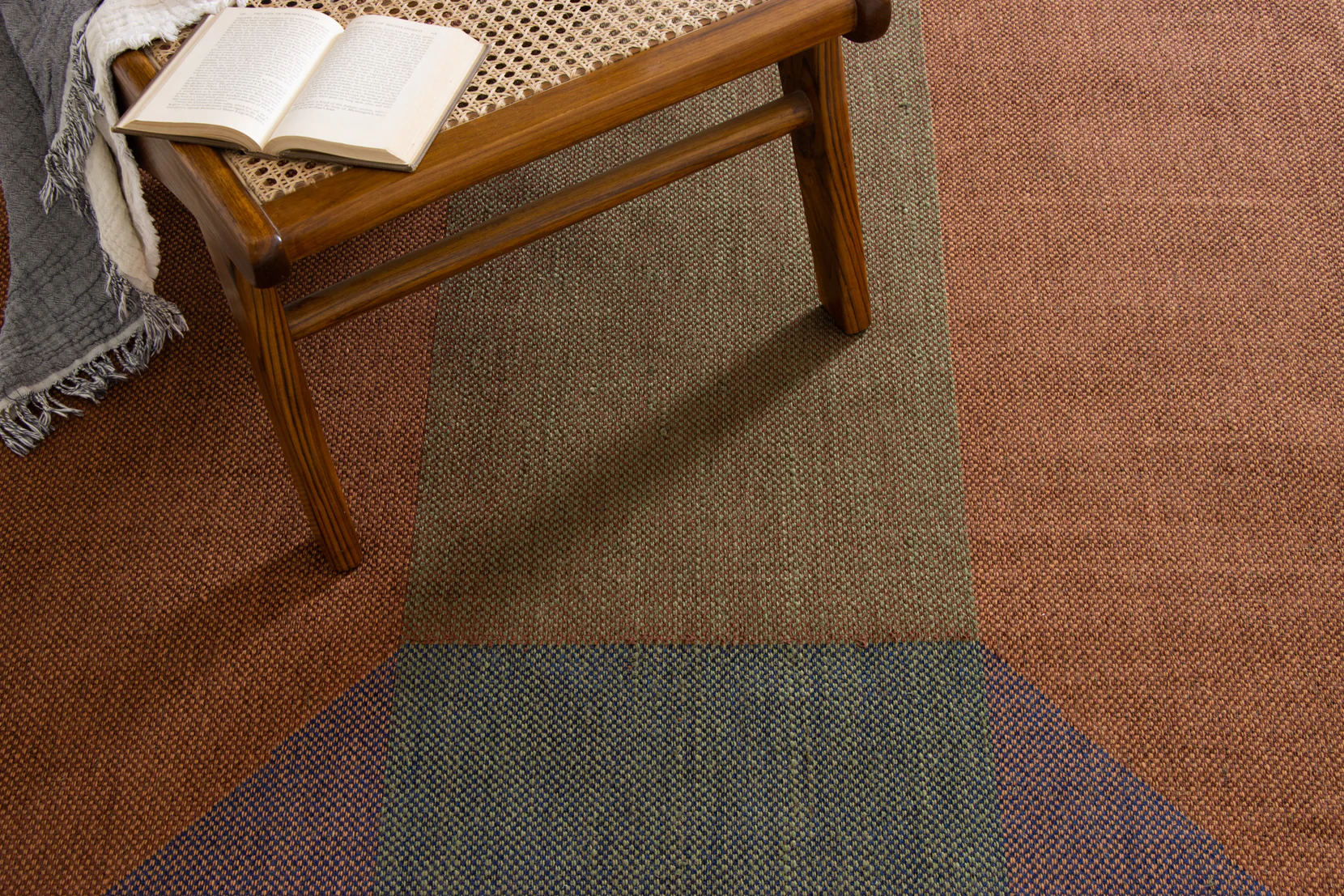


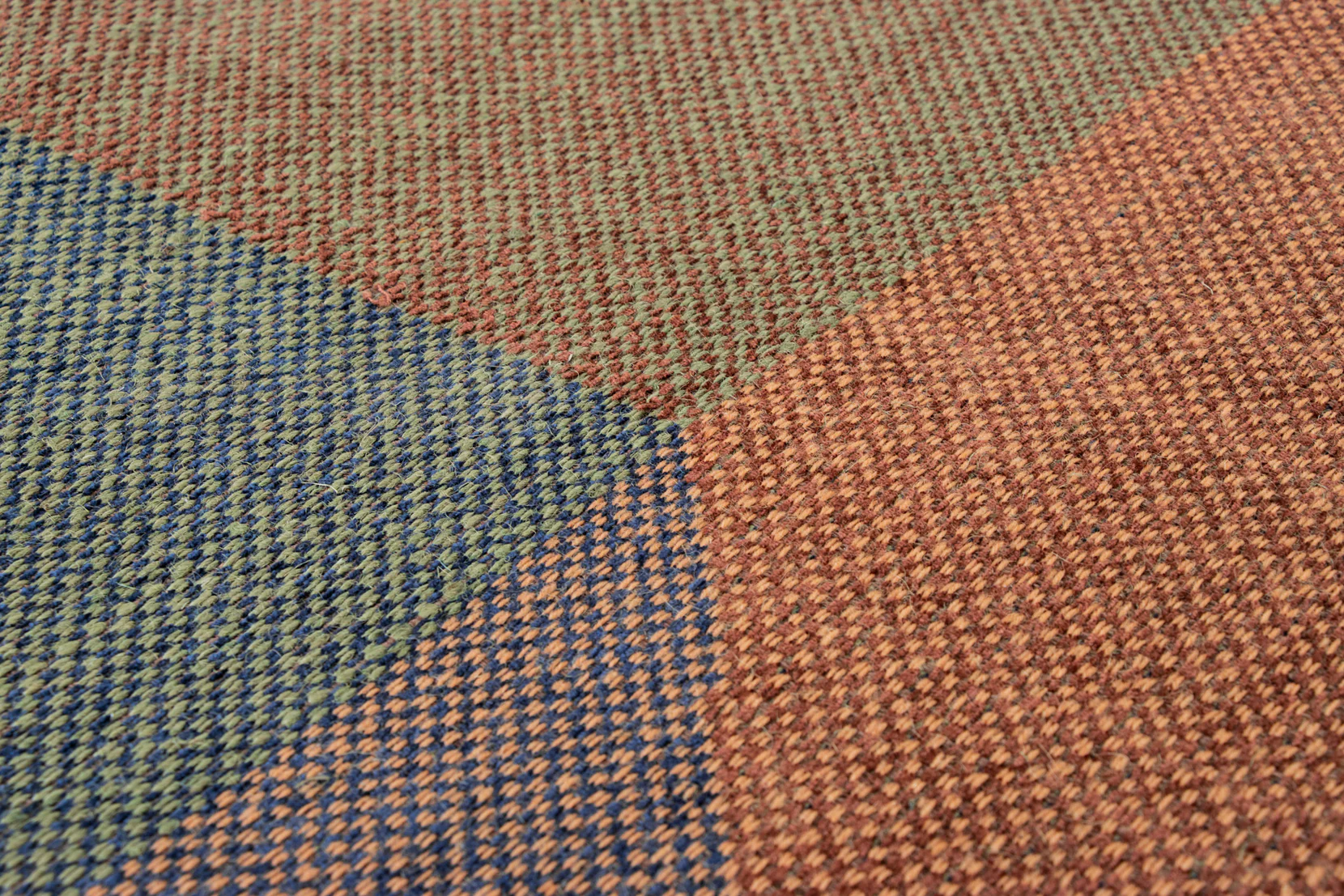


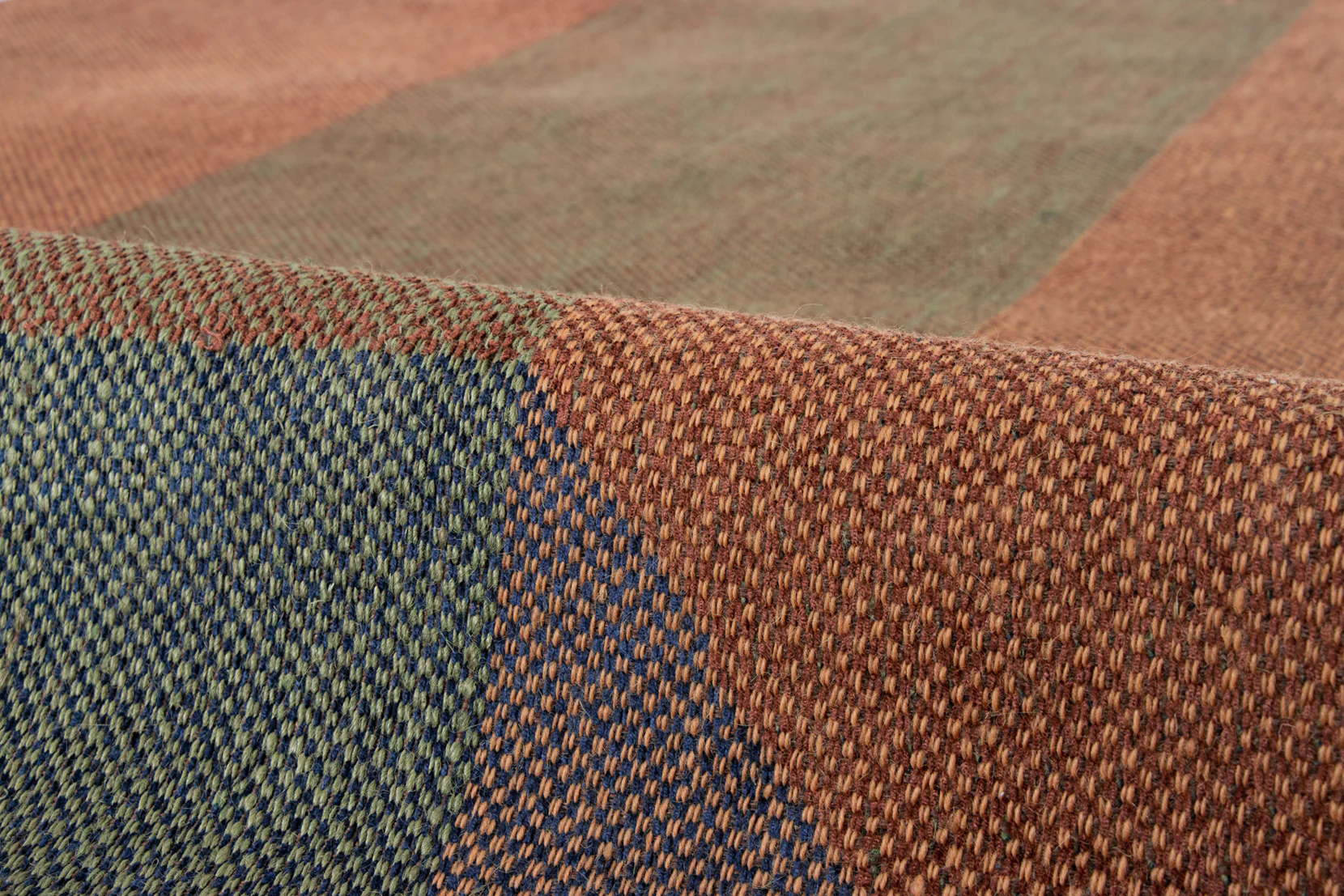


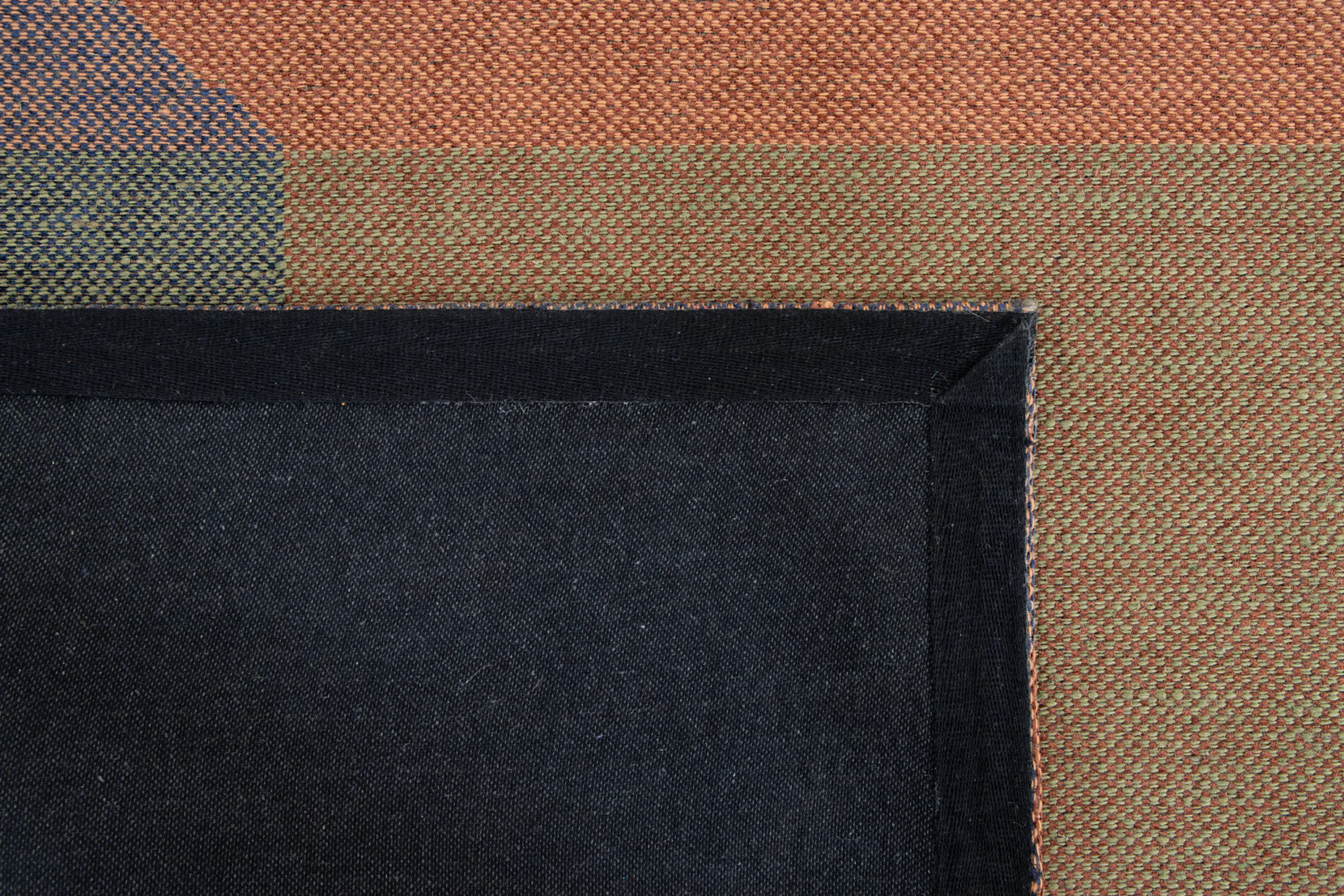


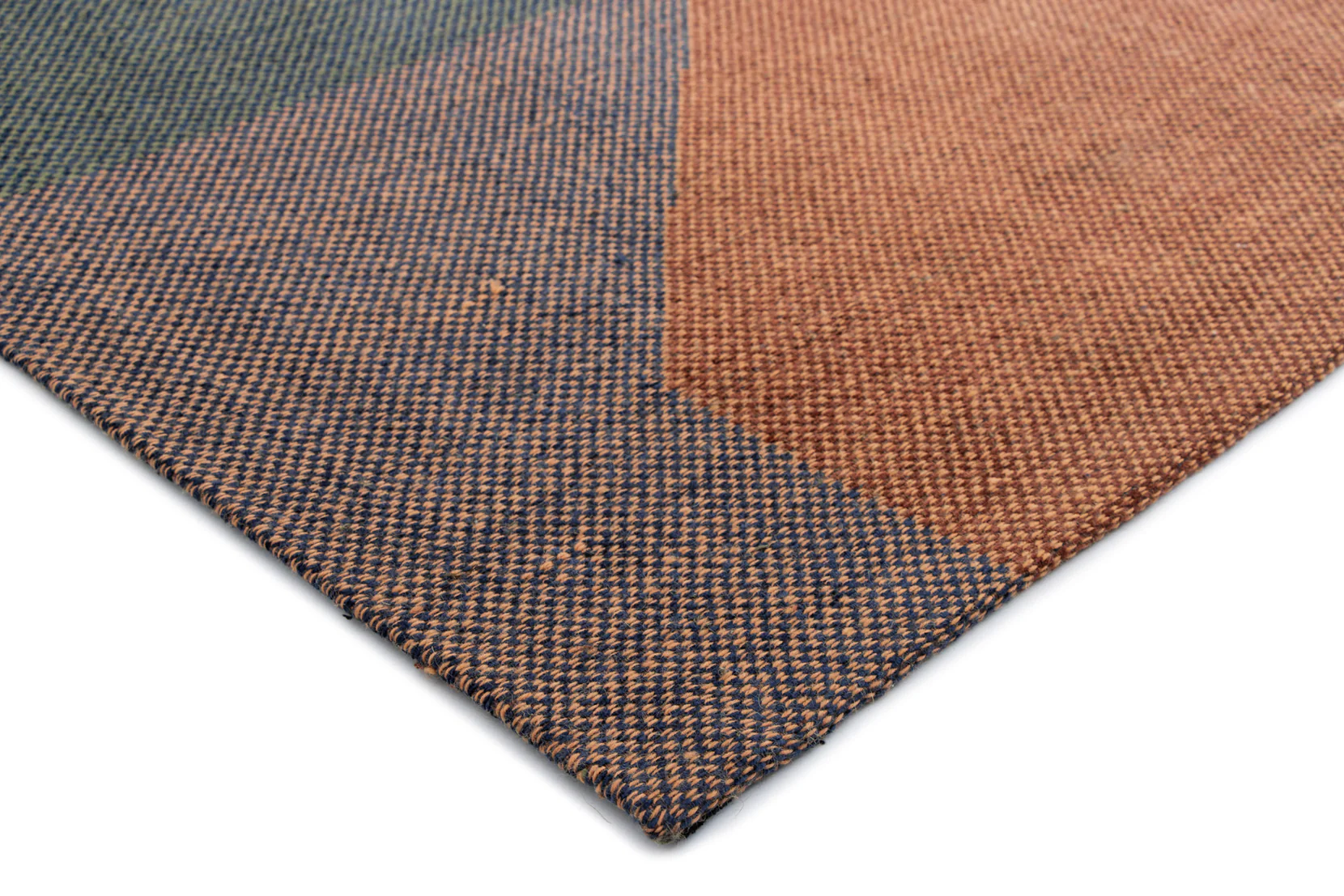

































































































































































































Mixed-fiber flatweave with a subtle checkered pattern
Rug Type:
-
Flatweave Rugs
Reversible rugs without pile, also known as kilims, made by hand-weaving horizontal weft yarns through vertical warp yarns
Age:
-
New
Recently woven and never used in a home
Main Color:
- Multicolor
Mixed-fiber flatweave with a subtle checkered pattern
- Jute, viscose, and wool on polyester foundation
- You may find traces of dried hay, grass, or straw in your rug as grazing sheep often collect plant matter in their coats. Remove gently by hand or with tweezers.
- Authentic wool fibers were used to weave this rug. Please note that when wool gets damp, it will smell like a wet sheep. This is the scent of lanolin, which acts as a waxy barrier against dirt and moisture.
- Jacquard-woven flatweave (1/3" or 9mm thick)
- Color palette: rust red, cantaloupe, navy, moss green
- Latex cotton backing
- Rug pad recommended for comfort, safety, and longevity
- Due to its handmade nature a 5% variance in size, color and texture is to be expected.
The Design
For our Reveal rugs, we played around with overlapping layers. Like with layers of paint, you can catch just a glimpse of both the colors in the intersection where they meet. To translate this into a weave, we used contrasting colors, focusing on the interaction of warp and weft. Named for Zion's sedimentary rock layers, Kaibab and Chinle have a kind of abrash effect, which on closer inspection is actually a micro-check pattern created by the movement of the warp and weft. Moenave and Kayenta have a slightly-less-micro-check pattern, where the interaction of colors is a bit more crisp.
The Material
In this piece, jute, wool, and viscose are blended for texture. Jute is a natural fiber with a golden sheen, known for its tensile strength and versatility. Wool has a hydrophobic layer which repels dust and dirt, as well as lanolin, which provides its trademark luster and protects the fiber from breaking or shedding. Viscose is extremely soft and durable, and beloved for its pleasing drape and ease in dying. A semi-synthetic plant material, it's derived from cellulose, which is the main element in plant cell walls. Finally, a latex cotton backing adds stability and strength.
The Maker
Our supplier got their start over 3 decades ago in yarn production. When they expanded into weaving, this material foundation gave them a distinct advantage, granting full control over the yarn quality and consistency of their handwoven rugs. They've always been a step ahead in innovation, collaborating with providers worldwide to procure the best raw material and machinery.
The Designer
Our in-house, all-star design team collaborates across three different countries. Based in Los Angeles, Istanbul, and Mumbai, they put a lot of thought into each and every collection they design. Starting with the weave itself, they determine material and technique, then create moodboards to capture the look and feel before starting to design. When designs are finalized, they conduct an extensive sampling process, perfecting each style and color before it goes to production.
- Vacuum on low power with a non-rotary (no spinning brush) vacuum or suction attachment only.
- Professional cleaning recommended as needed.
- Rotate your rug on occasion to ensure even wear over time.
- Keep away from excessive moisture.
- Due to the hand-crafted nature of our rugs, you can expect to see light shedding, matting, and signs of fiber and thread breakage over time. For high traffic areas, these effects may occur more quickly and easily.
- Spot cleaning instructions:
- Lightly dampen a paper towel or cloth with clean water
- Gently blot the affected area with your damp towel or cloth to dilute the stain
- If the stain persists, try using an unscented, citrus-free, clear soap to avoid bleaching the textile.
- Repeat this process until the stain is removed
Mixed-fiber flatweave with a subtle checkered pattern
Rug Type:
-
Flatweave Rugs
Reversible rugs without pile, also known as kilims, made by hand-weaving horizontal weft yarns through vertical warp yarns
Age:
-
New
Recently woven and never used in a home
Main Color:
- Multicolor
Mixed-fiber flatweave with a subtle checkered pattern
- Jute, viscose, and wool on polyester foundation
- You may find traces of dried hay, grass, or straw in your rug as grazing sheep often collect plant matter in their coats. Remove gently by hand or with tweezers.
- Authentic wool fibers were used to weave this rug. Please note that when wool gets damp, it will smell like a wet sheep. This is the scent of lanolin, which acts as a waxy barrier against dirt and moisture.
- Jacquard-woven flatweave (1/3" or 9mm thick)
- Color palette: olive green, sage green, maroon, rose quartz
- Latex cotton backing
- Rug pad recommended for comfort, safety, and longevity
- Due to its handmade nature a 5% variance in size, color and texture is to be expected.
The Design
For our Reveal rugs, we played around with overlapping layers. Like with layers of paint, you can catch just a glimpse of both the colors in the intersection where they meet. To translate this into a weave, we used contrasting colors, focusing on the interaction of warp and weft. Named for Zion's sedimentary rock layers, Kaibab and Chinle have a kind of abrash effect, which on closer inspection is actually a micro-check pattern created by the movement of the warp and weft. Moenave and Kayenta have a slightly-less-micro-check pattern, where the interaction of colors is a bit more crisp.
The Material
In this piece, jute, wool, and viscose are blended for texture. Jute is a natural fiber with a golden sheen, known for its tensile strength and versatility. Wool has a hydrophobic layer which repels dust and dirt, as well as lanolin, which provides its trademark luster and protects the fiber from breaking or shedding. Viscose is extremely soft and durable, and beloved for its pleasing drape and ease in dying. A semi-synthetic plant material, it's derived from cellulose, which is the main element in plant cell walls. Finally, a latex cotton backing adds stability and strength.
The Maker
Our supplier got their start over 3 decades ago in yarn production. When they expanded into weaving, this material foundation gave them a distinct advantage, granting full control over the yarn quality and consistency of their handwoven rugs. They've always been a step ahead in innovation, collaborating with providers worldwide to procure the best raw material and machinery.
The Designer
Our in-house, all-star design team collaborates across three different countries. Based in Los Angeles, Istanbul, and Mumbai, they put a lot of thought into each and every collection they design. Starting with the weave itself, they determine material and technique, then create moodboards to capture the look and feel before starting to design. When designs are finalized, they conduct an extensive sampling process, perfecting each style and color before it goes to production.
- Vacuum on low power with a non-rotary (no spinning brush) vacuum or suction attachment only.
- Professional cleaning recommended as needed.
- Rotate your rug on occasion to ensure even wear over time.
- Keep away from excessive moisture.
- Due to the hand-crafted nature of our rugs, you can expect to see light shedding, matting, and signs of fiber and thread breakage over time. For high traffic areas, these effects may occur more quickly and easily.
- Spot cleaning instructions:
- Lightly dampen a paper towel or cloth with clean water
- Gently blot the affected area with your damp towel or cloth to dilute the stain
- If the stain persists, try using an unscented, citrus-free, clear soap to avoid bleaching the textile.
- Repeat this process until the stain is removed
Order A Sample

Kaibab - Rug Sample
Size 12" x 12"
Free shipping & return
Recently Viewed
Kaibab Flatweave Rug
Don’t forget to bundle up! Buy 2 or more rugs, get 20% off your rugs.
![]() Free Shipping
Free Shipping
![]() Easy Returns
Easy Returns
Mixed-fiber flatweave with a subtle checkered pattern
Mixed-fiber flatweave with a subtle checkered pattern
- Jute, viscose, and wool on polyester foundation
- You may find traces of dried hay, grass, or straw in your rug as grazing sheep often collect plant matter in their coats. Remove gently by hand or with tweezers.
- Authentic wool fibers were used to weave this rug. Please note that when wool gets damp, it will smell like a wet sheep. This is the scent of lanolin, which acts as a waxy barrier against dirt and moisture.
- Jacquard-woven flatweave (1/3" or 9mm thick)
- Latex cotton backing
- Rug pad recommended for comfort, safety, and longevity
- Due to its handmade nature a 5% variance in size, color and texture is to be expected.
The Design
For our Reveal rugs, we played around with overlapping layers. Like with layers of paint, you can catch just a glimpse of both the colors in the intersection where they meet. To translate this into a weave, we used contrasting colors, focusing on the interaction of warp and weft. Named for Zion's sedimentary rock layers, Kaibab and Chinle have a kind of abrash effect, which on closer inspection is actually a micro-check pattern created by the movement of the warp and weft. Moenave and Kayenta have a slightly-less-micro-check pattern, where the interaction of colors is a bit more crisp.
The Material
In this piece, jute, wool, and viscose are blended for texture. Jute is a natural fiber with a golden sheen, known for its tensile strength and versatility. Wool has a hydrophobic layer which repels dust and dirt, as well as lanolin, which provides its trademark luster and protects the fiber from breaking or shedding. Viscose is extremely soft and durable, and beloved for its pleasing drape and ease in dying. A semi-synthetic plant material, it's derived from cellulose, which is the main element in plant cell walls. Finally, a latex cotton backing adds stability and strength.
The Maker
Our supplier got their start over 3 decades ago in yarn production. When they expanded into weaving, this material foundation gave them a distinct advantage, granting full control over the yarn quality and consistency of their handwoven rugs. They've always been a step ahead in innovation, collaborating with providers worldwide to procure the best raw material and machinery.
The Designer
Our in-house, all-star design team collaborates across three different countries. Based in Los Angeles, Istanbul, and Mumbai, they put a lot of thought into each and every collection they design. Starting with the weave itself, they determine material and technique, then create moodboards to capture the look and feel before starting to design. When designs are finalized, they conduct an extensive sampling process, perfecting each style and color before it goes to production.
- Vacuum on low power with a non-rotary (no spinning brush) vacuum or suction attachment only.
- Professional cleaning recommended as needed.
- Rotate your rug on occasion to ensure even wear over time.
- Keep away from excessive moisture.
- Due to the hand-crafted nature of our rugs, you can expect to see light shedding, matting, and signs of fiber and thread breakage over time. For high traffic areas, these effects may occur more quickly and easily.
- Spot cleaning instructions:
- Lightly dampen a paper towel or cloth with clean water
- Gently blot the affected area with your damp towel or cloth to dilute the stain
- If the stain persists, try using an unscented, citrus-free, clear soap to avoid bleaching the textile.
- Repeat this process until the stain is removed






